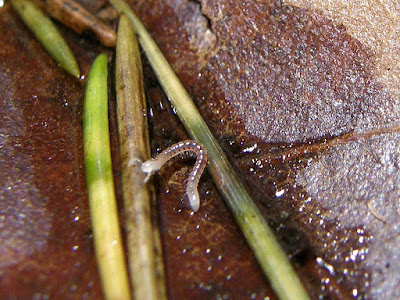Blaniulus gluttulatus, the spotted snake millipede?
This one is about 5.5 mm. long, or 1/4 inch, and looks as if it were made of glass, with red polka-dot decorations and milky head and tail.
The long "sticks" are pine needles.
Close-up of the spots.
I found them, or their close cousins, on BugGuide: juvenile spotted snake millipedes, an introduced species from Europe. BugGuide has photos from across America, from Massachusetts in the east, to Washington State, just south of here. The adult grows up to about an inch and a half, and may be up to five years old.
These millipedes are mainly subterranean (How do they stay so sparkling clean?); I only found them because I was turning over leaves that were half-buried in the topsoil and duff. They can become a pest in gardens, because of their diet of live plant matter. They like potatoes, carrots, and other root crops, including bulbs (my daffodils?).
The red spots along the sides are defensive glands:
Millipedes also use a variety of chemical defenses. Many have special repugnatorial glands that produce ill-smelling and/or caustic fluids that ooze through openings along the side. These fluids, which are mixtures of hydrocyanic acid, iodine and various quinones, can stain and irritate skin. Insects confined with a millipede may be killed by these substances. (From Millipedes of Colorado)
I like that word, "repugnatorial"!
Some of the millipedes on the leaf were about half the size of the one above.






Once again, you have highlighted a tiny yet amazing creature. Yellow spots, red spots, repugnatorial glands ... who would have thought!
ReplyDeleteOh yeah, I love that word repugnatorial as well. It's so very descriptive and fun!!!
I get millipedes in my potato barrels. I get all kinds of critters in there. They must come in the potting mix or on the seed potatoes. The pots are on the deck far from any other soil. Or maybe they materialize by magic. But they do love to chow down on the ones in the bottom of the barrel where it is a bit too moist.
ReplyDeleteStop on by today. I have a little surprise for you at my blog. - Margy
Anuket, It looks like your leaf veggies are safe. Check this page: the pied piper (UK). Another site says its a problem in Europe, but not on this continent.
ReplyDeletethat one crawled on my finger at my P.E class >.<
ReplyDelete